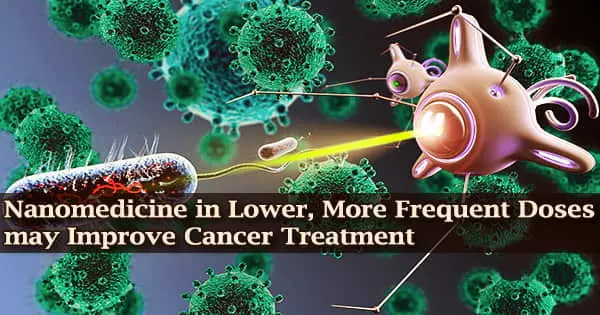Nanoparticles are tiny structures that can transport things to specific sections of the body, such as a chemotherapy medicine to a tumor. Although such “nanomedicine” held out hope for better cancer treatments, the survival benefits of clinically authorized nanomedicines are generally insignificant when compared to traditional chemotherapy.
Nanomedicine may deliver additional benefits if it is administered at lower, more frequent dosages called metronomic dosing rather than the typical maximum tolerated dose of current treatments, according to new research published in the Journal of Controlled Release.
“Nanomedicine and metronomic therapy have been regarded as two different approaches to treat cancer. Our analysis suggests that these two approaches can be viewed using the same unified framework as strategies to enhance treatment,” says co-corresponding author Rakesh K. Jain, Ph.D., director of the E.L. Steele Laboratories for Tumor Biology at Massachusetts General Hospital and the Andrew Werk Cook Professor of Radiation Oncology at Harvard Medical School.
According to Jain, metronomic therapy appears to help normalize the tumor microenvironment, which means it corrects some of the irregularities that occur around tumors and protect the tumor while also promoting its growth and spread.
While tumors can send out signals that disrupt normal blood flow and inhibit immune cell responses (both of which make them difficult to treat), metronomic therapy appears to increase blood vessel function and immune activation within tumors. Nanomedicines have been shown in preclinical investigations to elicit similar changes in the tumor microenvironment.
Nanomedicine and metronomic therapy have been regarded as two different approaches to treat cancer. Our analysis suggests that these two approaches can be viewed using the same unified framework as strategies to enhance treatment.
Rakesh K. Jain
“In this study, we hypothesized that nanoparticle formulations, given the controlled release of their payload and the long blood circulation time, can trigger the same cascade of activities as metronomic therapy,” says Jain.
The team demonstrated that both approaches may be used as “normalization tactics” to modify the tumor microenvironment and improve cancer treatments using a mathematical framework and mouse trials.
Doxil, a nanomedicine that is approved to treat metastatic breast cancer and consists of doxorubicin encapsulated in a lipid sphere administered through a metronomic schedule, could also overcome tumor resistance seen when Doxil is given through a standard dosing schedule in mice with triple negative breast cancer or fibrosarcoma.
A metronomic schedule also boosted the efficacy of Doxil with an immune checkpoint inhibitor, which is a sort of immunotherapy.
“Nano-immunotherapy, which combines nanomedicines with immunotherapy, has high potential to improve patient outcomes, and for this reason, understanding the mechanisms of resistance to and development of strategies to enhance nano-immunotherapy in breast and other cancer types is urgently needed,” says co-corresponding author Triantafyllos Stylianopoulos, PhD, director of the Cancer Biophysics Laboratory and associate professor at the University of Cyprus.
“The results of this work could be a basis for the planning of future clinical studies to improve the efficacy of nano-immunotherapy regimens.”
The findings imply that combining nanomedicines with metronomic scheduling can result in a potent attack on malignancies that are difficult to treat. These two techniques work together to regulate the tumor microenvironment, giving medications a better chance of accessing cancer cells and efficiently targeting them.
Fotios Mpekris and Myrofora Panagi (University of Cyprus), Chrysovalantis Voutouri (Massachusetts General Hospital), and James W. Baish (Massachusetts General Hospital) are among the study’s co-authors (Bucknell University).
This work was supported by grants from the National Foundation for Cancer Research, the Ludwig Center at Harvard; the Jane’s Trust Foundation; Nile Albright Medical Research Foundation; the U.S. National Cancer Institute grants R35-CA197743, R01-CA208205, R01-CA259253, R01NS118929, U01CA224348, U01CA261842 (to R.K.J.); the European Research Council (ERC-2013-StG-336839, ERC-2019-CoG-863955); and the Cyprus Research and Innovation Foundation (INFRASTRUCTURE/1216/0052, POST-DOC/0718/0084) (to T.S.), a Marie Sk?odowska Curie Actions Individual Fellowship Global (MSCA-IF-GF-2020-101028945) (to C.V.) and Grant R01 HL128168 (to J.W.B.).





